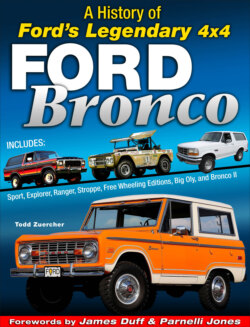Читать книгу Ford Bronco: A History of Ford's Legendary 4x4 - Todd Zuercher - Страница 20
На сайте Литреса книга снята с продажи.
170 I-6
ОглавлениеAt the Bronco’s introduction, the sole powerplant offered was the 170-ci 6-cylinder engine, euphemistically called the “spirited Big Six power” in early sales brochures. The 170 offered a maximum gross horsepower rating of 105 at 4,400 rpm and a maximum gross torque rating of 158 ft-lbs at 2,400 rpm. Bronco’s standard engine bested all of its competition. The closest was Scout’s 152-ci 4-cylinder, which came within 3.3 ft-lbs of Bronco’s net torque rating.
The Bronco debuted in August 1965 with a 170-ci 6-cylinder engine and a gross output of 105 hp. Often referred to as the “Falcon Six,” it was actually sourced from the Econoline van line and used solid lifters instead of the Falcon’s hydraulic units. The 1966 radiator had an offset cap; all other years’ radiators were centered. (Photo Courtesy Tim Hulick)
The 170-ci Six was known as the “Falcon Six,” having been introduced as an upgrade to the original 144 ci in the Falcon lineup in 1961. With a bore of 3.5 inches and stroke of 2.94 inches, the oversquare engine featured four main bearings and an intake manifold that was integrally cast with the cylinder head, limiting its performance potential. The compression ratio was a healthy 9:1. Typical of inline 6-cylinder engines, the 170’s torque curve was fairly flat, with 90 percent of maximum torque developed at an engine speed of 1,000 rpm. The Bronco version of the engine was actually developed from the Econoline van version of the engine, which featured solid mechanical lifters in lieu of the hydraulic lifters used in the Falcon engines.
Because Ford engineers knew that the Bronco would see more angles and inclines that cars would never travel, they modified the 1-barrel carburetor and mechanical fuel pump to provide a positive fuel supply under all conditions. On top of the carburetor, an oil-bath air cleaner was added for maximum air filtration. The Bronco’s oil pan held 7 quarts of oil; the Econoline version made do with 4.5 quarts.
The road tests of the first Broncos didn’t specifically complain about the lack of power with the 170, but instead obliquely made comments such as “No power options exist now, but compartment is big enough for a V-8” (Popular Science) and “A V-8 could easily slip in there” (Car Life photo caption).
Ford clearly intended to install a V-8 between the frame rails of its pony. As early as the first quarter of 1964, Ford documents indicated that Advanced Development Engineering was working on studies to provide for a 289-ci V-8 engine in the truck.
